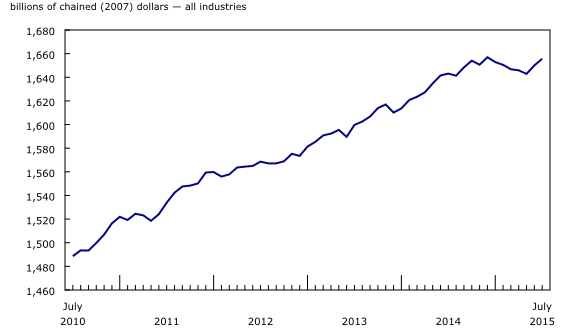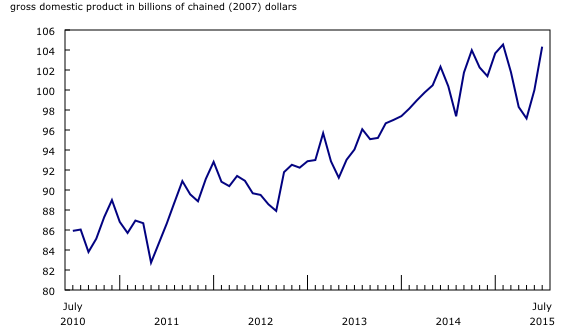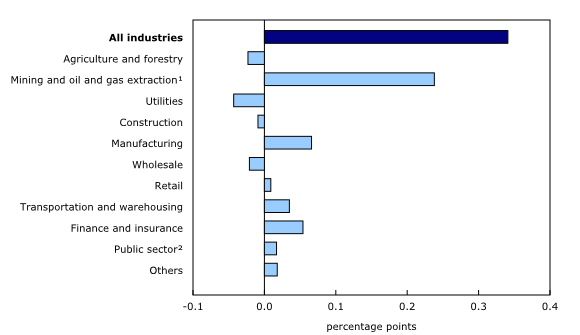Gross domestic product by industry, July 2015
Archived Content
Information identified as archived is provided for reference, research or recordkeeping purposes. It is not subject to the Government of Canada Web Standards and has not been altered or updated since it was archived. Please "contact us" to request a format other than those available.
Released: 2015-09-30
July 2015
0.3% 
(monthly change)
Real gross domestic product grew 0.3% in July, after rising 0.4% in June. The growth in June and July followed five consecutive monthly declines from January to May. The increase in July was led by mining, quarrying, and oil and gas extraction, manufacturing, and the finance and insurance sector.
The output of goods-producing industries rose 0.8% in July after a 0.7% increase in June, which followed five consecutive monthly declines. The rise in July was the result of a gain in mining, quarrying, and oil and gas extraction and, to a lesser extent, manufacturing. In contrast, utilities, the agriculture and forestry sector, and construction were down.
The output of service-producing industries advanced 0.2% in July, after increasing 0.3% in June and posting no growth in May. Notable gains were recorded in the finance and insurance sector, transportation and warehousing services, the public sector (education, health and public administration combined) and retail trade. On the other hand, wholesale trade, the arts and entertainment sector, and professional services declined.
Mining, quarrying, and oil and gas extraction expands again
Mining, quarrying, and oil and gas extraction expanded 2.9% in July after a 2.6% increase in June, which followed seven consecutive monthly contractions.
After increasing 2.9% in June, oil and gas extraction rose 4.4% in July mainly as a result of a 9.1% gain in non-conventional oil extraction. Non-conventional oil extraction continued to grow in July after increasing 7.0% in June, following maintenance shutdowns and production difficulties in April and May. Conventional oil and gas extraction was up 0.8% in July after edging up 0.1% in June.
Mining and quarrying (excluding oil and gas extraction) edged up 0.1% % in July, following a 2.7% rise in June. An increase in potash mining outweighed a decline in metal ore and coal mining in July.
Support activities for mining and oil and gas extraction fell 1.9% in July, after declining 0.7% in June.
Manufacturing output grows again
Manufacturing output rose 0.6% in July, after increasing 0.6% in June and declining 1.0% in May.
Durable-goods manufacturing increased 1.0% in July after edging up 0.1% in June. Notable gains were recorded in transportation equipment, fabricated metal products, miscellaneous manufacturing as well as furniture and related products. Conversely, computer and electronic product manufacturing, non-metallic mineral products manufacturing, machinery manufacturing as well as primary metal manufacturing were down.
Non-durable goods manufacturing increased 0.2% in July, after a 1.1% rise in June. Gains were posted in the manufacturing of food, plastic and rubber products, and beverage and tobacco products, while chemical manufacturing fell.
The finance and insurance sector rises again
After increasing 0.7% in June, the finance and insurance sector rose 0.8% in July. All of banking, financial investment and insurance services were up in July.
Wholesale trade falls while retail trade increases
Wholesale trade fell 0.4% July, following a 0.7% rise in June. Declines were notable in the wholesaling of farm products, petroleum products and miscellaneous products (which include paper products) in July. In contrast, the wholesaling of personal and household goods was up.
Retail trade rose 0.2% in July, after falling 0.2% in June. Motor vehicle and parts dealers and clothing and clothing accessories stores posted increases. In contrast, food and beverage stores, electronics and appliance stores and building material and garden equipment and supplies dealers recorded declines.
The arts and entertainment sector declines
The arts and entertainment sector declined 1.9% in July, following a 6.8% increase in June. The increase in June was due in large part to the FIFA Women's Soccer World Cup hosted by Canada. Levels in the industry remained high in July, in part because of increased activity related to the Pan-American games.
Construction decreases
Construction edged down 0.1% in July. Engineering, repair and residential building construction fell in July. In contrast, non-residential building construction was up.
The output of real estate agents and brokers was down 0.9% in July after a 0.2% decline in June, which followed four consecutive monthly increases.
Other industries
Utilities fell 1.9% in July, a fifth consecutive monthly decrease. A decline in electricity generation, transmission and distribution outweighed a gain in natural gas distribution in July.
The public sector (education, health and public administration combined) edged up 0.1% in July. Educational services were up, while public administration and health care services were unchanged.
Note to readers
The monthly gross domestic product (GDP) by industry data at basic prices are chained volume estimates with 2007 as the reference year. This means that the data for each industry and each aggregate are obtained from a chained volume index multiplied by the industry's value added in 2007. The monthly data are benchmarked to annually chained Fisher volume indexes of GDP obtained from the constant-price input-output tables up to the latest input-output tables year (2011).
For the period starting with January 2012, the data are derived by chaining a fixed-weight Laspeyres volume index to the prior period. The fixed weights are 2011 industry prices.
This approach makes the monthly GDP by industry data more comparable with the expenditure-based GDP data, chained quarterly.
All data in this release are seasonally adjusted. For information on seasonal adjustment, see Seasonally adjusted data – Frequently asked questions.
Revisions
With this release of monthly GDP by industry, revisions have been made back to January 2014.
Each month, newly available administrative and survey data across various industries in the economy are integrated and result in statistical revisions. Updated and revised administrative data (including taxation statistics), new information provided by respondents to industry surveys, and standard changes to seasonal adjustment calculations are incorporated with each release.
For more information about monthly national GDP by industry, see the System of macroeconomic accounts module on our website.
Next release
Data on GDP by industry for August will be released on October 30.
Real-time CANSIM tables
Real-time CANSIM table 379-8031 will be updated on October 7. For more information, consult Real-time CANSIM tables.
Contact information
For more information, contact us (toll-free 1-800-263-1136; 514-283-8300; infostats@statcan.gc.ca).
To enquire about the concepts, methods or data quality of this release, contact Allan Tomas (613-790-6570), Industry Accounts Division.
- Date modified:




